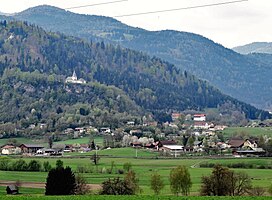Tiffen
|
Tiffen ( village ) locality cadastral municipality Tiffen |
||
|---|---|---|
|
|
||
| Basic data | ||
| Pole. District , state | Feldkirchen (FE), Carinthia | |
| Judicial district | Feldkirchen | |
| Pole. local community | Steindorf am Ossiacher See | |
| Coordinates | 46 ° 42 '20 " N , 14 ° 3' 30" E | |
| height | 560 m above sea level A. | |
| Residents of the village | 174 (January 1, 2020) | |
| Building status | 68 (2001) | |
| Area d. KG | 4.75 km² | |
| Statistical identification | ||
| Locality code | 01124 | |
| Cadastral parish number | 72340 | |
| Counting district / district | Tiffen (21009 002) | |
 View of Tiffen |
||
| Source: STAT : index of places ; BEV : GEONAM ; KAGIS | ||
Tiffen is a cadastral community of Steindorf am Ossiacher See in the political district of Feldkirchen and has 200 inhabitants.
history
The oldest settlement in the municipality of Steindorf is the small village of Tiffen between Feldkirchen and Steindorf on the former Noric iron road; it nestles picturesquely around a steep rockfall, which is crowned by the old fortified church . The name, written “Tyven” in 1050, is of Celtic or pre-Illyrian origin. In Roman times the place was a post office .
In prehistoric times, there was a Celtic cult site on the site of today's parish church , a Jupiter temple from the 2nd to the 4th century , and the Romans , after the Celts, operated a quarry in the immediate vicinity .
Culture and sights
Former castle
In 878 Tiffen is mentioned for the first time as "the place by the red rock" ( Latin rubra petra ). The Bavarian Count Ozzi von Tiffen is the founder of the Ossiach Abbey . The place and the later rule of Tiffen came through the Counts of Eppenstein to the Counts of Treffen. In 1163 Wolfrad von Treffen , his wife Hemma and Patriarch Ulrich II von Treffen handed over their property in Treffen and the neighboring Tiffen to the Patriarchate of Aquileja . Tiffen Castle has also been mentioned since 1163. For two centuries Tiffen remained in the possession of the Aquileia Patriarchate. Throughout the Middle Ages it was an object of pledging and barter, but also of the struggle between the Carinthian dukes, the dioceses of Bamberg and Gurk and their owners.
In the 15th century, when a new long-distance trade route from Murau via Weitensfeld - Zammelsberg - Feldkirchen to Italy emerged, road tolls had to be paid in Tiffen for all these goods; only the citizens of Feldkirchen were exempt from paying this “toll” from 1453 onwards. At that time there was an imperial governor in Tiffen who temporarily exercised jurisdiction in the 16th century. For a time the rule came to the Khevenhüller and the Count Lodron von Himmelberg .
Because of the many fights - also with external enemies - the castle fell into disrepair very quickly, nothing of it has survived , but the former farmyard of the castle north below the church on a plateau above the village in the valley, still called "Gschlosser" today .
Parish Church of Saint James the Elder
The church is Romanesque and was built in the 9th or 10th century. In the 15th century it was gothicized into a two-aisled nave and expanded in 1758 with a baroque choir. The high altar and pulpit also date from this period . Roman stones are walled in on the outside.
Rectory
Opposite the church is the current rectory, which used to be a schoolhouse. In 1878 the famous Carinthian master of woodcuts and fresco painter Switbert Lobisser (as Leo Lobisser) was born there; the fresco on the outside wall of the church comes from him.
Former rectory
The old castle-like rectory is located on the north side of the steep slope. The church and parsonage were fortified in the 15th century, of which there are still considerable remains with a round tower . The many tunnels in the surrounding forests go back to a mining operation in the Middle Ages.
The rectory is the house where Switbert Lobisser was born .
Filial church St. Margarethen
The small Roman Catholic Church of St. Margarethen with Romanesque origins is located in the village. It is a branch church of the parish Tiffen. On the south facade remains of frescoes show St. Margarethe with dragon and St. Katharina with a wheel as an attribute .
Galgenbichl
The hill south of the Feldkirchen - Tiffen road is called Galgenbichl, it bears the traces of a very old fortification and has been a place of execution since the early Middle Ages. The legend reported that once roasted pigeons, which were presented to the governor of Tiffen as a court, came back to life and flew out through the open window as proof of the innocence of a young person who had been condemned to death by the keeper and who was on the Galgenbichl to be executed.
traffic
The Tiffen stop is on the St. Veit / Glan – Villach section of the former Rudolfsbahn .
literature
- DEHIO Carinthia - topographical inventory of monuments . Verlag Anton Schroll, Vienna 2001, ISBN 3-7031-0712-X , pp. 952-956.
- Austrian art topography. Volume I: Duchy of Karnten . In commission at Kubasta & Voigt, from the KK Hof- und Staatsdruckerei, Vienna 1889, pp. 338–339
Web links
Individual evidence
- ^ Karl August Muffat: The Counts of Treffen in Carinthia as a branch of the Alemannic dynasty of the Counts of Veringen-Alshausen . Munich 1855, p. 550.





